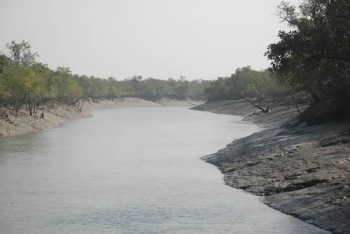Sundarbans National Park

Sundarbans National Park protects the Indian part of the Sundarbans delta, which is covered by the largest mangrove forest in the world.
The mangrove system is rich in both flora (78 mangrove species have been recorded) and fauna. Tigers, spotted deer, dolphins, river terrapins, and king cobras are among its inhabitants. The area comprises forests and wetlands, including waterways, mudflats, and small islands that are constantly being changed by the action of the tides.
Community Perspective: Solivagant has described how to “visit” this site, although the core zone was strictly off-limits during his stay (2013). Els shares what a day trip to the Sundarbans from Kolkata involves and has an update on getting closer to the core zone (2024).

Map of Sundarbans National Park
Community Reviews
Els Slots

As I had been to the Bangladeshi Sundarbans already in 2007, the visit to its Indian counterpart felt superfluous: this should be one transboundary WHS of course. And it felt even more like a chore because the visitor experience on the Indian side doesn’t come exactly recommended: I scouted for a “better” lodge to stay the night or a more imaginative tour, but all come with mixed reviews (or worse) online. So I settled for a private day trip from Kolkata. This one also suffered from poor communication beforehand, but fortunately, the logistics on the day itself worked perfectly.
A driver picked me up at 5 a.m. from my Kolkata hotel. The drive to Godhkali this early in the morning takes only 2h15 minutes (on the way back, it would be 3 hours). When you leave Kolkata’s city limits, the typical landscape dominated by creeks and channels begins.
In Godhkali, I was handed over like a postal package to a ferryman who put me on land at the next island, and on his turn delivered me to a waiting taxi that drove me in 15 minutes across the island to another dock. This is a densely inhabited island, it looked quite idyllic but it has suffered greatly from the devastating cyclone in 2020 and is also at risk due to rising water levels. It is protected by a low mud dike covered in plastic that looks very sketchy.
My private boat was waiting at the second dock – it came with a crew of what I first thought were two men but when breakfast suddenly appeared it turned out a woman was working in the kitchen downstairs as well. We first went to Sajnekhali to report to the park authorities. Here we also picked up a park guide, who doubled as general interpreter as he was the only one speaking English well. At the station, we had a quick look at the aquarium where they have a joint Indian-Bangladeshi breeding program for the critically endangered Northern River Terrapin.
From Sajnekhali, we then turned right. The guide said that most tourist boats go left – especially those with Indians as all they want to see are the two observation towers and take selfies with the plastic animals. We cruised along in all quietude, during the whole trip we only encountered one other tourist boat (with 2 foreigners on board). Weekends are the busiest days in the park, which is closed on Tuesdays.
The thing to observe here in the Sundarbans is how plants and animals have adapted to a life with brackish water and high tidal differences. It was funny to see the colour differences in the mangrove trees: the upper part is green, the lower part whiteish indicating exactly up to where the water level rises daily. Birds thrive in these surroundings (lots of branches to sit on and fish to catch), but the other animals had to adjust their “lifestyle”. Monkeys find few fruits here so they turn to anything edible (I saw one devouring a bird, photo 2), and deer are known to eat crabs.
For the first hour, we navigated the part that locals may use for fishing. We saw several small boats at work. Nets fully encircle the protected zone: to prevent tigers from swimming to the inhabited islands. We then turned into the narrower creeks and into the 'tourist zone' where fishing is forbidden and the nets no longer obstructed views. It felt very pristine and I saw no rubbish floating around at all.
As time passed by (we were on the water for 5 hours) the water levels started rising, which made the observation of animals even more difficult as there were no mud banks left and the animals retreated into the thick mangrove forest. During the whole trip, we saw multiple groups of monkeys (rhesus macaques), two wild boar, and one spotted deer (photo 1: taken with a superzoom lens as it was deep in the bushes). Large monitor lizards (photo 3) were common, but crocodiles we only saw one.
Like all others who've shared their visits on this website, I only visited the buffer zone of the WHS as the core zone is a strict reserve aimed at tiger conservation. But there is a way to get closer to the core zone: at the Netidhopani Watch Tower. Visitors need a permit. It takes 4 hours from Sajnekhali by boat, so it's possible only for those staying overnight. This spot is also where the plaque is. Your chance of good wildlife sightings won't be significantly better, however; a tiger will stroll by once every 1-2 weeks.
Read more from Els Slots here.
Suvankar Chakraborty
India(West Bengal) - 25-Feb-14 -
I was in Sunderban, West Bengal quite a number of times to conduct a study of mental health status and needs of the survivors after two years of disaster due to Aila ( name given by Maldwip for separate identity), that occurred on 25th May, 2009 in the Southern parts of West Bengal and Bangladesh because of formation of devastating cyclone in the Bay of Bengal . While conducting my study at 8 No. Khaikhali and Deulbari, in the Kultali Block; P.O.- Ashram , I met some of the affected people like Nirupada Mondal (Fisherman), Nirmal Naskar (Autorickshaw Driver) , Rabin Naskar (Boatman), Ramini Das( Runs rented shop in Ram Krishna Mission, Khaikhali), Bishnu Pada Sardar (Farmer).... they narrated the horrible situation in Aila cyclone-affected villages of Khaikhali and Deulbari. It was not just an opportunity for me to extend my understanding of extent of disaster but also to listen to the needs of people struggling for survival. According to Nirupada Mondal immediately after disaster the survivors in the villages have been facing scarcity of food, drinking water because of the fact that sea-water ruining their freshwater ponds, and that was responsible for several survivors suffering from diarrhoea after having no choice but to drink the saline water, and loosing the means of earning livelihood as they have traditionally been dependant on agriculture that has been ruined by the saline water from Bay of Bengal that had entered their farms.
Solivagant

We had previously visited the Bangladesh Sundarbans back in 2006 and had enjoyed the experience so we decided to give the Indian WHS a try when we flew in/out of Kolkata on a trip to the NE of India.
The drive south from Kolkata takes around 2.5 hours and this gets you to one of a number of jetty points from where to travel onwards – ours was at Gothkhali. From there boats are available into the Sundarbans (though you can get further by public transport across several islands by short ferries and auto/cycle rickshaws). By boat the official entrance is a further 2 + hours further on mostly through heavily populated areas on either side of a mainly narrow waterways. We had arranged an overnight at the Sundarban Tiger Camp situated just outside the park (reasonable standard) but first went to the Park HQ at Sajnekhali for registration/payment of fees etc. The only accommodation inside the park is here but our lodge was only across the river at Dayapur.
Sajnekhali was a disappointment. Its caged area contains a reasonable interpretation centre and a concrete watch tower but the distinct lack of any significant wildlife most of the time from that tower had been “compensated” for by the distant positioning of laughable, life size, plastic animals such as tiger! The Sundarban tours which operate from there are conducted in traditional-hulled motor boats with a cabin and a deck verandah, capable, I guess, of taking some 10 tourists (though most, like ours) operated for just 2 PAX. The tour consisted of various routes through the mangrove-lined rivers. During these transits the occasional deer, monkey and crocodile were readily visible as was a reasonable range of birds. The main destinations for such tours were other watch towers – in our case at Dobanki and Sudhanyakhali. These were set out with “site lines” cleared of undergrowth and stretching several hundred metres in several directions across which no doubt animals do occasionally pass. Similarly there were man-made scrapes which no doubt attracted animals looking for a drink. However, the fact that the hours during which the mangroves can be visited means that one can’t actually reach these towers at day break or stay until dusk significantly reduces one’s chances of seeing much.
We were particularly amazed by the relatively recent construction of a half km concrete “Canopy Walkway” at Dobanki. This seemed to go nowhere of any likely interest at all! We were told that it crossed a fenced area in which a captive group of deer had been kept but that these had been release to provide “tiger food”. This fence is a significant double construction but sits beyond the walkway which only passes over the “deer park” What a waste of money. Our visit was in any case totally ruined by a group of workers with hammers and pick axes who were repairing the fences around the area and scared off anything which moved!
During our visit high tide was occurring at around noon – this was unfortunate as the best time to see wild life and beyond the green mangrove foliage, is at low tide when the mangrove roots and sandy banks are exposed. If you have a choice and can find out tide times try to synchronize your visit with as much “low tide” as you can.
At Sajnekhali the way of life of peoples living around the Sundarbans is explained and this is, to some extent, on view in the form of fishermen and shrines to Bonbibi the guardian spirit of the forest who is believe by the locals to protect honey gathers and wood cutters from the demon king Dakkhin Rai who appears in the form of a tiger. However the Tiger reserve is not supposed to be open to mixed use except to limited numbers at e.g honey gathering time.
Possibly the most surprising aspect of the Indian Sundarbans is that tourists are NOT actually allowed into any part of the inscribed sit – only its buffer zone!! This fact is “fudged” both at the site itself and in the UNESCO documentation. So the UNESCO Web site contains a map titled “Sundarban Tiger Reserve” even though the inscribed site is titled “Sundarban NP”. There is also an entity called “Sundarban World Biosphere Reserve”. The Sundarban Tiger reserve (which where one is taken when visiting the “Sundarbans”, is a subset of the World Biosphere reserve but excludes ANY part of the National Park. These 2 quotes from the Periodic Reprt of 2003 describe the situation -
“Tourists are not allowed to visit the WHS. However, the tourists visiting Sundarban Tiger Reserve are … :
YEAR 1991 Number of Visitors 22049 etc”
And
“There is no tourism within the WHS, as the property has been kept outside the '"Tourism Zone" to provide strict protection to this wonderful natural landscape. All the tourists are confined to the adjoining buffer zone of similar values to ensure the integrity of the WHS. The buffer Zone of Sunderban Biosphere Reservc, which is also the buffer of Sundarban National Park (WHS) and has the status of Wildlife Sanctuary & that of Reserve forest, provides following facilities to the visitors. -
I. Mangrove Interpretation Ccnters at Sajnekali & Bliagabatpur.
2. Five Watch towers with cage path.
3. A tourist lodge at Sajnekali.”
The Mangrove Interpretation Centre at Sajnekhali includes signs describing the Sundarbans as a WHS and showing the boundaries of the Biosphere reserve but do not make it clear that Sajnakhali is only in a buffer zone of the National Park.
In conclusion, even excepting the fact that one can only enter the WHS buffer zone, the Indian Sundarbans don’t, in our opinion, offer a visiting experience anywhere near as good as that in the Bangladesh Sundarbans (see my review). If you have never seen Mangrove swamps and are in Kolkata it is just about worth going. Similarly if you just love such locations – otherwise I would give it a miss!
Manju Das
I went to Sundarban World Heritage site with my son in a cruise named M.V.Paramhansha. It started from Millenium Park on Friday. Some Foreigners are there also. We enjoyed thoroughly our trip. It's 3 days trip. First day we stay near Namkhana. Next day we went to visit different Islands with a small boat. Food was really tasty and healthy. To see the different cricks and crevices you will be thrilled. The silence itself a beauty over there. Jungle birds like Cranes, Water ducks,Parrots,Titir,KingFishers are really interesting. If you see the different tributaries of River Hoogly it's amazing. Sundari plants are main vegetation overthere. 7 different rivers meet at different points. Like Hoogly, Matla, Saptaparni, Caning, Brahamaputra, Padma and Ganges are really worthwhile.
If you see the different flora and fauna over there by watch tower at different islands you can locate spotted deers, Cuckoo,mudskippers,moniter lizards, Crocodiles and turtles too. The people stays over there are very poor. Only they can avail fish and honey.
Agriculture is there like (Paddy and Sunflower). Some areas are covered with Solar power. Internal arrangement of cruse is really excellent.
Jaydip
Sundarbans, locals called Snderbunds. Now Sndarbans and its tigers are making news every day. Tigers are getting in the villages for easy prey. All these make Sundarbans more and more popular every day. But heard from tourist, that they never seen tiger there with repeated visit. Very recently I went to Sundarbans and found lots of people are traveling there. It is good for locals as they able to get quick money. But I found the crowd makes lots of noises, especially on weekends. Tracking a tiger is hard in the dense bush, but if you give more time to certain watch towers then your chances will be bigger. For this you need to spend more silent hrs there. You can try Trips2world.net for specialized tiger safari packages in Sundarbans.
V.Mohan
It is important for tourists to know that the chances of seeing the tiger in this place is very very less. The main reason is that the jungle is inacessible by land, and one hs to use a motor boat. Since narrow creeks cannot be traversed using the motor boats, one generally end up cruising in the river, expecting soem animal to come by to cross the river. In this sense, unlike other jungles where animals are actively pursued using pug marks, other clues, in this place, one ends up passively waiting for the animal to some how come to the banks of the river. Also in package tours the time at the watch tower is only about 15 miniuts, the rest of the time is for travelling from the camp o the watch towers by boat. Staff was cooperative and kind. The village and the villagers were simple and loving. But the main purpose of the trip i.e to watch wild life is genearally defeated. We could not even spot a monkey in the three days at the camp.
Community Rating
Site Info
- Full Name
- Sundarbans National Park
- Unesco ID
- 452
- Country
- India
- Inscribed
- 1987
- Type
- Natural
- Criteria
-
9 10
- Categories
- Natural landscape - Rivers, Wetlands and Lakes
- Link
- By ID
Site History
1987 Inscribed
Site Links
Unesco Website
Official Website
Related
In the News
Connections
The site has 34 connections
Ecology
Geography
Human Activity
Literature and Film
Timeline
Trivia
Visiting conditions
WHS Names
WHS on Other Lists
World Heritage Process
Visitors
36 Community Members have visited.
The Plaque
 (photo by Solivagant)
(photo by Solivagant)